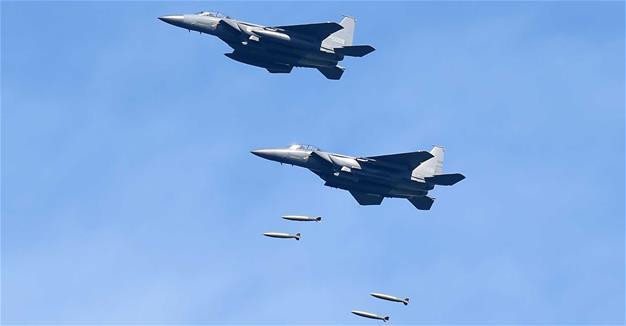US flies bombers, jets after North Korea test
SEOUL/TOKYO

South Korea said its air force conducted an exercise with two U.S. nuclear-capable bombers above the Korean peninsula on Aug. 31, two days after a North Korean missile fired over Japan sharply raised tensions.
The drills, involving two supersonic U.S. B-1B bombers, four U.S. stealth F-35B jets as well as South Korean fighter jets, came at the end of annual joint U.S.-South Korea military exercises focused mainly on computer simulations.
North Korea strongly objects to the exercises, which it sees as a preparation for invasion and has responded with a series of threats and missiles launches in recent weeks.
U.S. President Donald Trump has responded with his own threats, warning North Korea it would face "fire and fury" if it threatened the United States and that the U.S. military was "locked and loaded" in case of any provocation.
Trump on Aug. 30 declared "talking is not the answer" to resolving the long-standing impasse with North Korea.
"The U.S. has been talking to North Korea, and paying them extortion money, for 25 years," Trump, who last week said North Korean leader Kim Jong Un was "starting to respect" the United States, wrote on Twitter.
"Talking is not the answer!"However, U.S. Defence Secretary Jim Mattis, when asked by reporters just hours later if the United States had run out of diplomatic solutions with North Korea, replied: "No."
"We are never out of diplomatic solutions," Mattis said before a meeting with his South Korean counterpart at the Pentagon. "We continue to work together, and the minister and I share a responsibility to provide for the protection of our nations, our populations and our interests."
Japanese Defence Minister Itsunori Onodera spoke to Mattis by telephone and agreed to keep putting pressure on North Korea in a "visible" form, Japan's defence ministry said.
Russian Foreign Minister Sergey Lavrov, meanwhile, has warned U.S. Secretary of State Rex Tillerson that potential new sanctions against North Korea would be “dangerous.”
Lavrov and Tillerson spoke by phone late Aug. 30, several hours after Trump’s tweet.
Russia’s Foreign Ministry said in a read-out of the call late Aug. 30 that both Lavrov and Tillerson condemned North Korea for firing a midrange ballistic missile Japan earlier this week and called for dialogue.
Lavrov told Tillerson that Russia urges all parties to avoid a military solution to the crisis and added that Moscow views any new potential sanctions against North Korea as “counterproductive and dangerous.”
The 15-member U.N. Security Council on Aug. 29 condemned the firing of an intermediate range ballistic missile over Japan as "outrageous," and demanded that North Korea halt its weapons programme, but the U.S.-drafted statement did not threaten new sanctions.
Japan was pushing the United States to propose new U.N. Security Council sanctions, which diplomats said could target North Korea's labourers working abroad, oil supply and textile exports.
Diplomats expected resistance from Russia and fellow veto-wielding power China, particularly given new measures were only recently imposed after North Korea staged two long-range missile launches in July.
Asked if Japanese Prime Minister Shinzo Abe and Trump talked about restricting North Korea's fuel supply when the two spoke by telephone on Aug. 30, Chief Cabinet Secretary Yoshihide Suga said an embargo on oil and oil-related products would be an option.
A U.S. ban on travel to North Korea comes into effect on Aug. 31, curbing one of its few remaining supplies of foreign currency.
China, North Korea's neighbour and main ally and trading partner, again urged restraint from all parties.
Defence ministry spokesman Ren Guoqiang told a monthly briefing that China would never allow war or chaos on its doorstep and that military means were not an option.
The situation on the peninsula was serious and "not a computer game" foreign ministry spokeswoman Hua Chunying told a briefing.
Early in August, North Korea announced plans to fire four missiles into the sea near the U.S. Pacific territory of Guam.
The Pentagon's Missile Defense Agency and the crew of the guided-missile destroyer USS John Paul Jones conducted a "complex missile defense flight test" off Hawaii on Aug. 30, resulting in the intercept of a medium-range ballistic missile target, the agency said.
The agency's director, Lieutenant General Sam Greaves, called the test "a key milestone" in giving U.S. Navy Aegis Ballistic Missile Defense ships an enhanced capability, but did not mention North Korea.
The United States and South Korea are technically still at war with North Korea because their 1950-53 conflict ended in a truce, not a peace treaty.
North Korea routinely says it will never give up its weapons programmes, calling them necessary to counter perceived American hostility.
 South Korea said its air force conducted an exercise with two U.S. nuclear-capable bombers above the Korean peninsula on Aug. 31, two days after a North Korean missile fired over Japan sharply raised tensions.
South Korea said its air force conducted an exercise with two U.S. nuclear-capable bombers above the Korean peninsula on Aug. 31, two days after a North Korean missile fired over Japan sharply raised tensions.